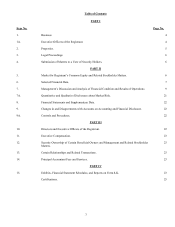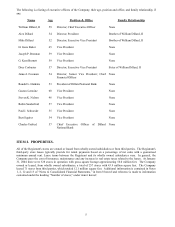Dillard's 2003 Annual Report Download - page 18
Download and view the complete annual report
Please find page 18 of the 2003 Dillard's annual report below. You can navigate through the pages in the report by either clicking on the pages listed below, or by using the keyword search tool below to find specific information within the annual report.Vendor allowances. The Company receives concessions from its vendors through a variety of programs and
arrangements, including co-operative advertising, payroll reimbursements and markdown reimbursement programs. Co-
operative advertising allowances are reported as a reduction of advertising expense in the period in which the advertising
occurred. Payroll reimbursements are reported as a reduction of payroll expense in the period in which the
reimbursement occurred. All other vendor allowances are recognized as a reduction of cost purchases. Accordingly, a
reduction or increase in vendor concessions has an inverse impact on cost of sales and/or selling and administrative
expenses.
Insurance accruals. The Company’s consolidated balance sheets include liabilities with respect to self-insured workers’
compensation and general liability claims. The Company estimates the required liability of such claims, utilizing an
actuarial method, based upon various assumptions, which include, but are not limited to, our historical loss experience,
projected loss development factors, actual payroll and other data. The required liability is also subject to adjustment in
the future based upon the changes in claims experience, including changes in the number of incidents (frequency) and
changes in the ultimate cost per incident (severity).
Finite-lived assets. The Company evaluates the fair value and future benefits of finite-lived assets whenever events and
changes in circumstances suggest. The Company performs an analysis of the anticipated undiscounted future net cash
flows of the related finite-lived assets. If the carrying value of the related asset exceeds the undiscounted cash flows, the
carrying value is reduced to its fair value. Various factors including future sales growth and profit margins are included
in this analysis. To the extent these future projections or the Company’s strategies change, the conclusion regarding
impairment may differ from the current estimates.
Goodwill. The Company evaluates goodwill annually and whenever events and changes in circumstances suggest that
the carrying amount may not be recoverable from its estimated future cash flows. To the extent these future projections
or our strategies change, the conclusion regarding impairment may differ from the current estimates.
Accounts receivable securitizations. As part of the credit card securitizations, the Company transfers credit card
receivable balances to the Trust in exchange for certificates representing undivided interests in such receivables. The
Trust securitizes balances by issuing certificates representing undivided interests in the Trust’s receivables to outside
investors. In each securitization the Company retains certain subordinated interests that serve as a credit enhancement to
outside investors and expose the Trust assets to possible credit losses on receivables sold to outside investors. The
investors and the Trust have no recourse against the Company beyond Trust assets. In order to maintain the committed
level of securitized assets, the Trust reinvests cash collections on securitized accounts in additional balances. Interest
paid to outside investors is recorded as interest expense.
Currently all borrowings under our receivable financing conduit are recorded on balance sheet and included in “Long-
term Debt” on the consolidated balance sheet. As of January 31, 2004 and February 1, 2003 we had $400 million of
debt, respectively, outstanding under this agreement. Prior to May 2002, we accounted for securitizations of credit card
receivables as sales of receivables, thus off balance sheet.
Income taxes. Temporary differences arising from differing treatment of income and expense items for tax and
financial reporting purposes result in deferred tax assets and liabilities that are recorded on the balance sheet. These
balances, as well as income tax expense, are determined through management’s estimations, interpretation of tax law for
multiple jurisdictions and tax planning. If the Company’s actual results differ from estimated results due to changes in
tax laws, new store locations or tax planning, the Company’s effective tax rate and tax balances could be affected. As
such these estimates may require adjustment in the future as additional facts become known or as circumstances change.
Discount rate. The discount rate that the Company utilizes for determining future pension obligations is based on the
Moody’s AA corporate bond index. The indices selected reflect the weighted average remaining period of benefit
payments. The discount rate determined on this basis had decreased to 6.0% as of January 31, 2004 from 6.75% as of
February 1, 2003.
12
























